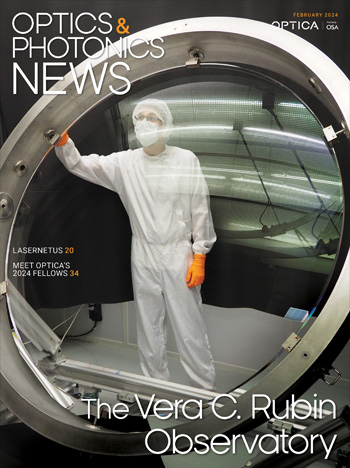
April 2001 Issue
Feature Articles
Micromachining using ultrashort pulses from a laser oscillator
Oscillator-only micromachining in action. A train of femtosecond pulses from a laser oscillator is focused by a microscope objective into a thin glass sample. The bright blue spark is due to recombination of the electrons that are nonlinearly ionized by the pulses. Permanent structural changes are produced in the material at the laser focus.
by Chris B.Schaffer and Eric MazurOptical Vortices Folding and Twisting Waves of Light
Intensity distribution in an optical beam carrying a vortex (mesh) and its helical wave front (color surface).
by Yuri S. Kivshar and Elena A. OstrovskayaTwo Thousand Years of Ocean Optics
Throughout the twentieth century, improved methods have led to an increasingly detailed understanding of the physical, chemical, and biological processes controlling the distribution of light in the ocean.
by Sophia JohannessenChoose Your Color from the Photonic Band EdgeNonlinear Frequency Conversion
Optical vortices—phase singularities or phase defects in electromagnetic waves—constitute a unique and fascinating class of phenomena within the context of the physics of light, displaying a deep similarity to their close relatives, quantized vortices in superfluids and Bose–Einstein condensates.
by Michael Scalora, Mark J. Bloemer, Charles M. Bowden, Giuseppe D’Aguanno, Marco Centini, Concita Sibilia, Mario Bertolotti, Yannick Dumeige, Isabel Sagnes, Petar Vidakovic, and Ariel LevensonPhotodiode Front Ends: The Real Story
Photodiode front ends are by no means glamorous. Living between the detector and the signal processing system, they're supposed to turn a photocurrent into a buffered, filtered electronic replica while preserving the signal-to-noise ratio (SNR). Nobody notices them until they stop doing their jobs. Your optical system may be a thing of great beauty, but a badly designed front end can sink those precious photoelectrons deep in Johnson noise. My unscientific sampling suggests that unfortunately a great many front ends are badly designed: the usual mistake is to trade SNR for speed without a fight. This article will describe techniques for building fast front ends without sacrificing SNR.
by Philip C. D. Hobbs
![A multiplexed image of a human tonsil acquired. [NIAID] using the iterative bleaching extends multiplexity (IBEX) method.](https://opnmedia.blob.core.windows.net/$web/opn/media/images/articles/2024/0424/departments/202404-cover-web.jpg?ext=.jpg)

